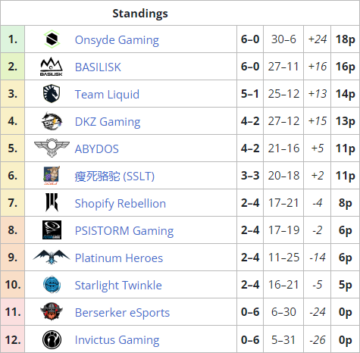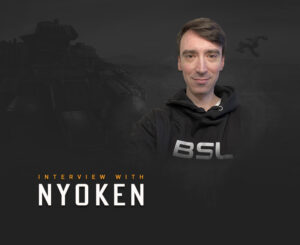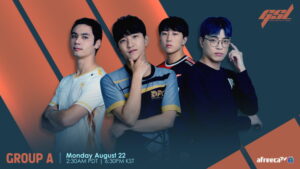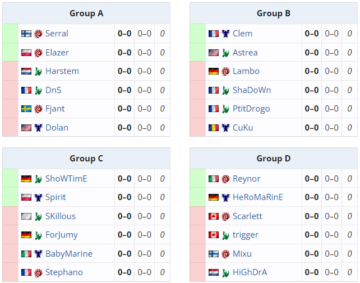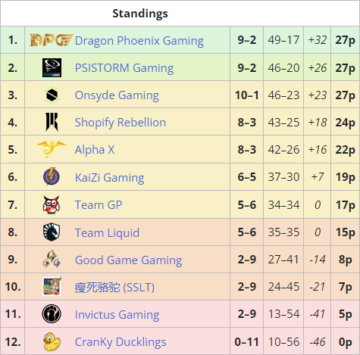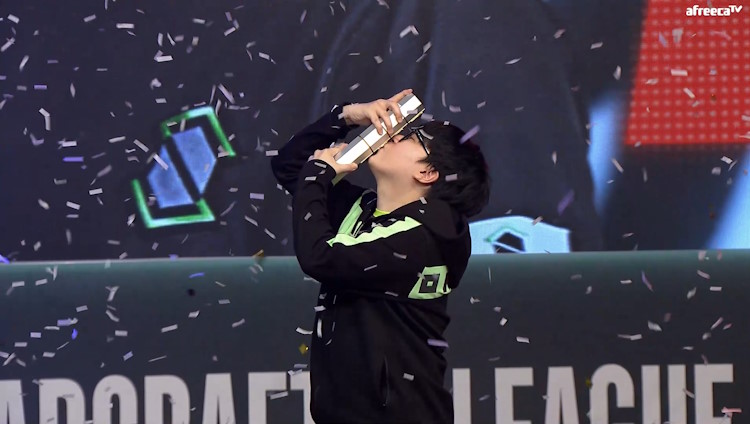
Solar wins first Code S championship after ten years in GSL
All good things come to those who wait? In Solar’s case, we should say all good things come to those who persevere. After ten years and thirty-two seasons of competing GSL Code S, the veteran Zerg finally won Korea’s most prestigious StarCraft II trophy with an emphatic 4-1 victory over GuMiho in the Code S Season 3 finals.
Solar was no stranger to championships, having previously won six Liquipedia premier-tier tournaments in his career, including the 2016 StarCraft II Starleague Season 2 (a tournament that was once equivalent to GSL Code S). Besides championships, he had earned numerous podium placements in major events, including a top four finish in this year’s richly-prized Gamers8. Yet, Korea’s most hallowed competition was grievously fallow ground for Solar. In thirty-one previous seasons of Code S, Solar had never advanced past the round-of-eight. This streak defied the conventional wisdom of StarCraft II, as virtually every player with a similar career resume to Solar had stepped on the GSL semifinals stage at least once.
“When you come into the GSL studio, the [pictures] of champions are hanging on the wall.” said Solar in the post-finals interview. “Looking at them, I often wondered ‘when will I win one, too?'”
Fittingly, it was in-game perseverance that led Solar to his first Code S championship, as his defensive macro style led him to victory over his famously tricky opponent. GuMiho didn’t bring any unorthodox builds to the finals—unlike the semifinals against Classic where he unveiled a deadly 2-base mech all-in—but instead stuck to the standard macro play that saw him defeat Solar earlier during the group stages of the tournament. However, Solar turned out to be the far more solid in the rematch, deflecting GuMiho’s early/mid-game aggression and winning with swarms of Hydralisks and Banelings later on. Solar had erred in their prior meeting by expending his armies too wastefully, but this time around he was somehow both unrelenting and measured at once.
After his 3-0 victory against Dark earlier in the night (a blink-and-you’ll-miss-it series centered around early game cheese), Solar had brought up a familiar reason for his breakthrough this season: playing in a calm and relaxed state of mind. For many GSL competitors, pressure is a more daunting opponent than the player in the opposite seat—overcoming that pressure may have played a key part in Solar breaking his career-long GSL jinx. Even Solar’s now-iconic lucky pajamas were an item he began wearing specifically to feel more at home in the GSL studio.
His long-awaited championship was finally in hand, but Solar’s mind was already focused on the future. During the post-finals interview, he turned the tables on caster Park Sang Hyun and asked a question of his own. “The GSL is going to keep going, right?” Park replied “Of course! How many years have we been here now?”
Without an official statement from AfreecaTV or further comment from AfreecaTV CEO Jung Chan Yong (who gave a thank you speech to the fans after the finals), this wasn’t the airtight, 100% confirmation that many were looking for. However, for Solar, and fans who want to see more stories like his come to fruition, it gave a glimmer of hope that the GSL, too, might persevere.
*****
Finals night actually began in the semifinals, with GuMiho defeating Classic 3-1 in the first round -of-four bout. GuMiho started the series off by beating Classic with his signature mech, but he gave up the tying point after he unwisely tried it again versus the adaptive Protoss. Classic’s own attempt to be creative didn’t pan out, and GuMiho took the 2-1 lead after holding off a Tempest rush. Finally, the two got to playing an orthodox TvP game in game four, where GuMiho’s frenzied infantry attacks toppled Classic in the late game.
The second semifinal between Solar and Dark almost felt like a caricature of ZvZ created by the match-up’s biggest anti-fan, with Solar taking a 3-0 sweep in under 20 minutes of total game time. Early game gambits decided everything, and Solar played the right card three games in a row.
The pre-finals interview featured some mild trash talk, with both players mentioning how the other was a much more preferable opponent than someone like Maru. The most interesting comment came from GuMiho, who said he had prepared more for Dark than Solar, and would thus be reusing his strategies from their earlier RO8 match. In hindsight, this was a very honest answer from GuMiho, who played a similar, orthodox macro style. Only this time, Solar simply played better in almost every facet of the game, allowing him to win the high-stakes rematch.
Match Recaps
[embedded content]
Semifinal #1: GuMiho [3-1] Classic
Game One – Solaris (GuMiho win): GuMiho unleashed mech play right off the bat, using his signature strategy to take game one.
GuMiho’s opener involved him pressuring with an motley mixture of Reaper-Hellion-Cyclone-Raven, all while he prepared for a 7:30 mech all-in off of two bases. This attack totally dismantled Classic’s defensive-Colossus opener, aided by some over-teching on Classic’s end. Ravens locked down the key Robotics units and let the Terran army move into deep siege position, leading to the GG.
Game Two – Hard Lead (Classic win): GuMiho attempted the exact same all-in mech strategy in game two, but this time Classic adapted and tied the score.
Instead of rushing to Colossus as his main defense unit as in game one, Classic instead played a defensive Blink opener that transitioned into mass Gateway units. Classic focused more on unit production this time around, which allowed him to narrowly hold against the anticipated mech push (which was still quite threatening). GuMiho didn’t waste any time after his all-in was thwarted, surrendering at just after the eight minute mark.
Game Three – Oceanborn (GuMiho win): Classic tried to turn the tables on GuMiho with an unorthodox fast-Tempest strategy, but he just couldn’t make it work against the Terran’s infantry-focused opener.
GuMiho swapped to more conventional play in this game, going for a Reaper expansion into 3-Barracks. Meanwhile, Classic swung for the fences with a bizarre Oracle into 2-Stargate Tempest build. While this did manage to inflict a decent amount of damage over time at GuMiho’s natural (thanks to the air-friendly terrain on Oceanborn), it came nowhere close to buying him enough time to build a credible ground defense against Terran bio. After some very effective multi-prong Medivac-Bio harass, GuMiho charged through the front door to force the GG.
Game Four – Hecate (GuMiho win): The two players finally had a proper macro bout in game four, which concluded with GuMiho winning with his chaotic style.
GuMiho started with a Cloaked Banshee harass opener while Classic went for defensive Blink. This initially worked out quite well for Classic, who took barely any damage as he prepared to hit a mass Zealot-Stalker timing with fast Storm. However, the game swung back in GuMiho’s favor after Classic botched his attack by fighting into well-spread arcs of Terran infantry.
Classic had skimped heavily on upgrades to hit his timing, which left him quite vulnerable to GuMiho’s first major counterattack. While Classic managed to survive after a close battle, the lead remained with GuMho who had firm map control.
GuMiho decided to play the rest of the game out without risking anything in another main army engagement, instead using his mobility and map control to keep denying Classic’s expansions and forcing the Protoss to scramble around. This worked beautifully for GuMiho, and he took the series deciding GG after holding off a last ditch attack from a starved Classic.
Semifinal #2: Solar [3-0] Dark
[embedded content]
Game One – Hecate (Solar win): The opening map was over in a flash, as Solar’s 12-pool Zergline-Drone-Spine Crawler all-in swept the leg from under Dark and his Hatch-first build. One of Solar’s two offensive Spine Crawlers managed to survive, which gave him just the edge he needed to win in the low-econ scenario.
Game Two – Hard Lead (Solar win): Early-game defense was the key to Solar winning in game two, as he held off Dark’s Ling-Bane aggression and snowballed to an economic win.
The game started with both players mirroring each other, taking three bases and building early Ling-Bane armies. Then, the two Zergs diverged with Dark cutting Drones at 24 for heavy Ling-Bane aggression, while Solar Droned up to 32 before preparing his defenses following a good Zergling scout. The eight Drone lead managed to be quite easy for Solar to defend, as he thoroughly beat Dark in the Ling-Bane knife fight.
From there, Solar executed the macro snowball to perfection, overrunning Dark with mass Roach-Ravager in under ten minutes (with Mutas thrown in for style).
Game Three – Solaris (Solar win): Solar defeated Dark in a duel of 1-base builds to end the series in under twenty minutes of combined game time,
Dark decided it was his turn to open with a 12-pool this time around, but followed it with an expansion instead of a Drone-Spine all-in. On the other hand, Solar took the more extreme approach, starting 12 gas-pool for very early Ling-Bane pressure.
Dark’s play was too ‘honest,’ as he sent his Zerglings directly to Solar’s base under an Overlord scout path. On the other hand, Solar cleverly sent his Zerglings through a side path, avoiding Dark’s Overlords for as long as possible. This meant Dark didn’t realize what Solar was up to until the last second, leading to a very delayed defensive Baneling Nest. Dark had a tiny chance of holding if he could pull off some miraculous micro, but instead he GG’d out at 3:20 after losing most of his Zerglings to a single Baneling.
Grand Final: Solar [4-1] GuMiho
[embedded content]
Game One – Goldenaura (Solar win): Game one went to Solar after he outmuscled GuMiho in a fairly straight-up game.
GuMiho opened 2-Barracks Reapers to start, followed by 3-CC, then followed by 2/1/1 Marine-Medivac with fast +1 attack. None of GuMiho’s early/mid-game offensive moves achieved any success, and Solar very comfortably macroed up into mass Hydra-Ling-Bane production.
Thanks to the defense-friendly terrain on Goldenaura, GuMiho was able to go up to four bases without getting completely swarmed over. However, Solar made damn sure GuMiho was not going to take a fifth base, slamming his forces into the Terran defenses every time they made an attempt to inch forward into the fifth.
GuMiho traded well on defense, and things even started to feel slightly dicey for Solar as he rapidly depleted his bank. In the end, there was nothing to worry about, as GuMiho’s bases dried up before he could really start to worry Solar. Down to a 1.5-base income, GuMiho was forced into a desperation offensive to try and secure a new expansion behind it. Solar swatted down this attack handily and received GuMiho’s surrender.
Game Two – Alcyone (Solar win): GuMiho continued his orthodox bio play in game two, and once again met his end at the hands of Solar’s strong macro play.
The early game went well for Solar once more, as he held off GuMiho’s 2-Barracks 5-Reaper opener without much trouble. Even so, GuMiho’s follow-up drops of Mines, Hellbats, and Marines—which barely killed any Drones at all—tied up Solar’s attention and bought time for GuMiho to crank out SCV’s and build a strong economy of his own. Both players bypassed any serious mid-game aggression after that (for GuMiho, possibly due to forgetting Combat Shields for a few minutes), and they went into the late-game in high-economy situations.
While GuMiho took his fifth base unopposed this time around, taking the expansion proved to be much easier than defending it. Solar poked all around GuMiho’s perimeter with his Hydra-Bane-Viper swarm, and found that the Terran defenders were stretched out too thin. Solar made the most poorly defended base his target, and he inflicted heavy casualties on the portion of GuMiho’s army he found there. This small breach soon turned into a wide open door, as GuMiho couldn’t reinforce nearly as quickly as Solar. The Zerg swarm continued to flood in, and after a few waves of attacks, GuMiho had to concede defeat once more.
Game Three – Site Delta (Solar win): Solar took his third game straight by holding off a 3-base Marine-Marauder all-in from GuMiho.
Gumiho gave things a change in the beginning with a CC-first build, which he followed up with a Mine-drop and an Armory. This was basically just a diversionary tactic (and possibly a mech-fake) while he went up to 3-base Bio play. Again, Solar was content to just defend and Drone up, going into mass Hydra-Bane production.
Rather than play for a more prolonged bout like in games one and two, GuMiho committed to a 3-base Marine-Marauder all-in. He chose a composition with almost entirely infantry and very little splash support save some leftover Hellbats and Mines from the early game (amusingly enough, the two Mines he had ended up doing a surprising amount of damage).
Unfortunately for GuMiho, he just couldn’t pierce through the defenses of a Zerg churning out Hydra-Bane off of 84 Drones, and he GG’d out after his parade push ran out of steam.
Game Four – Hecate (GuMiho win): GuMiho finally got some himself going with Marine-Medivac play in the early/mid-game, setting himself up for a late-game victory down the line.
Gumiho opened with what was basically a 2/1/1 with a few twists, but still seemed to fall into the mid-game hole after his initial Marine-Medivac movements failed to hamper Solar. However, he found some openings as he continued to prowl around the edges of Zerg territory. GuMiho pulled off textbook two-prong tactics to cancel multiple attempts from Solar at taking a fifth base, pinning the Zerg back in his corner of the map. While GuMiho wasn’t able to press his offensive any further, this put him in the best mid-game position so far in the series as he took bases at will and set himself up for the late game.
Solar played relatively well from his poor position, patiently staying on four bases until he could ‘bust out’ with Hydra-Bane-Viper as if he was the Terran player. However, he was still playing catch-up against a Terran who was well on his way to splitting the map and winning by attrition. GuMiho also had the luxury of playing very Tank-heavy in this particular game (even after he gated six of them inside his main base by mistake), making every single one of his bases hard to approach. In the end, Solar couldn’t even get to a 50/50 map split, and had to concede after he was ground down by GuMiho.
Game Five – Solaris (Solar win): Solar stuck to his winning formula and GuMiho still had no answer. After another rock-solid macro performance, Solar took the fourth and final win.
GuMiho pulled out the 2-Rax 5-Reaper opener once more, and yet again Solar held it off without taking much damage. The follow-up harassment with frontal attacks + drops didn’t shake Solar either, and we headed into another mid-game where Solar was freely pumping out Hydra-Ling-Bane off of a strong economy. GuMiho wasn’t in terrible shape, but the game seemed like it would once again come down to whether or not he could take and hold a fifth base.
The situation took a positive turn for GuMiho when Solar misread the Terran army positioning and sent a significant chunk of his army to harass the enemy fourth base. Solar ended up scrambling to defend against a Terran force he did not expect to be roaming around his outermost expansions, taking some Drone damage in the process. This gave GuMiho the breathing room to establish bases four and five, and try to settle into a defensive stance.
However, Solar was having none of that, and set about attacking back and forth between the far apart expansions. This really put the hurt on GuMiho, who looked like he was on the verge of collapsing. He managed to just barely hang on in the game, with a handful of bad trades from Solar preventing him from throwing in the towel. Still, the situation was still well in hand for Solar, who had been swallowing up the whole map in the meanwhile. He slowed down the pace slightly, allowing GuMiho to ‘stabilize’ on around a 33:66 split of the map.
After taking a brief pause to gather himself and reload, Solar set about closing out the game for good, using a combination of ground units and Brood Lords to extract the final GG from a resilient GuMiho.
- SEO Powered Content & PR Distribution. Get Amplified Today.
- PlatoData.Network Vertical Generative Ai. Empower Yourself. Access Here.
- PlatoAiStream. Web3 Intelligence. Knowledge Amplified. Access Here.
- PlatoESG. Carbon, CleanTech, Energy, Environment, Solar, Waste Management. Access Here.
- PlatoHealth. Biotech and Clinical Trials Intelligence. Access Here.
- Source: https://tl.net/forum/starcraft-2/618044-solar-wins-code-s-season-3-2023
- 1
- 12
- 20
- 2023
- 24
- 30
- 32
- 33
- 500
- 66
- 7
- 84
- a
- A side
- able
- About
- achieved
- actually
- adaptive
- advanced
- after
- again
- Against
- All
- allowed
- Allowing
- almost
- already
- also
- amount
- an
- and
- Another
- answer
- anticipated
- any
- Anything
- apart
- approach
- ARE
- Army
- around
- as
- At
- attack
- attacks
- attempt
- attempts
- attention
- back
- bad
- Bank
- base
- BAT
- Battle
- BE
- beat
- beautifully
- been
- before
- began
- beginning
- behind
- besides
- BEST
- Better
- between
- Biggest
- Blink
- both
- bought
- breach
- Breaking
- breakthrough
- breathing
- bring
- brought
- build
- Building
- builds
- bust
- but
- Buying
- by
- came
- card
- Career
- case
- centered
- ceo
- Champions
- Championship
- championships
- chan
- chance
- change
- charged
- chose
- Classic
- close
- closing
- code
- combat
- combination
- come
- comment
- committed
- competing
- competition
- competitors
- completely
- composition
- concluded
- confirmation
- content
- continued
- Control
- conventional
- corner
- could
- couldn
- CounterAttack
- created
- Creative
- credible
- cutting
- damage
- Dark
- decided
- deep
- Defense
- defensive
- defied
- delayed
- Delta
- DID
- didn
- directly
- doing
- door
- down
- Drone
- Drones
- drops
- due
- DUEL
- During
- each
- earlier
- Early
- earned
- easier
- easy
- Economic
- economy
- Edge
- Effective
- either
- embedded
- end
- ended
- engagement
- enough
- entirely
- equivalent
- establish
- even
- events
- Every
- everything
- executed
- expansion
- expect
- extract
- extreme
- Failed
- fall
- familiar
- famously
- fans
- far
- FAST
- favor
- featured
- feel
- felt
- few
- fight
- Fighting
- Final
- Finally
- finish
- Firm
- First
- five
- Flash
- flood
- focused
- followed
- Following
- For
- force
- forced
- forces
- forcing
- formula
- forth
- Forward
- found
- four
- from
- front
- fruition
- further
- future
- game
- Games
- Gaming
- gated
- gateway
- gather
- gave
- Get
- getting
- GG
- glimmer
- go
- going
- good
- got
- Ground
- Group
- had
- hand
- hands
- harassment
- Hard
- Have
- having
- he
- headed
- heavily
- heavy
- held
- here
- him
- himself
- Hindsight
- his
- HIT
- hold
- holding
- hole
- Home
- honest
- hope
- How
- however
- HTTPS
- i
- if
- ii
- in
- in-game
- Including
- Income
- inflict
- info
- initial
- initially
- INSIDE
- instead
- interesting
- Interview
- into
- involved
- Is
- IT
- jpg
- just
- keep
- Key
- korea
- last
- late
- later
- lead
- leading
- least
- Led
- left
- let
- like
- Line
- Little
- locked
- Long
- looked
- looking
- Lords
- losing
- luxury
- Macro
- made
- main
- major
- make
- Making
- manage
- managed
- many
- map
- mark
- mass
- Match
- May
- meant
- Meanwhile
- Meeting
- met
- micro
- might
- mind
- mines
- minute
- minutes
- mirroring
- mobility
- more
- most
- move
- movements
- much
- multi-prong
- multiple
- Natural
- nearly
- needed
- Nest
- New
- Night
- no
- None
- not
- nothing
- now
- numerous
- of
- off
- offensive
- official
- often
- on
- once
- One
- only
- open
- opened
- opening
- opposite
- or
- oracle
- Other
- out
- over
- Overlord
- own
- pace
- PAN
- part
- particular
- Past
- path
- pause
- perfection
- performance
- perseverance
- pierce
- placements
- plato
- plato data intelligence
- platodata
- platogaming
- play
- Play For
- played
- player
- players
- Playing
- podium
- Point
- poor
- position
- positioning
- Positive
- possible
- possibly
- preferable
- prepared
- preparing
- press
- pressure
- prestigious
- preventing
- previous
- previously
- prior
- Process
- Production
- proper
- proved
- pumping
- push
- put
- question
- quickly
- quite
- rapidly
- Ravens
- realize
- really
- reason
- received
- reinforce
- relatively
- relaxed
- remained
- REST
- resume
- right
- robotics
- room
- round
- rush
- rushing
- s
- Said
- same
- save
- saw
- say
- scenario
- score
- season
- second
- secure
- see
- seemed
- sent
- Series
- set
- setting
- settle
- shape
- should
- side
- signature
- significant
- similar
- Simply
- single
- site
- situation
- situations
- SIX
- small
- So
- so Far
- solar
- Solaris
- solid
- some
- somehow
- someone
- Soon
- specifically
- spine
- split
- splitting
- stabilize
- Stage
- stages
- stance
- standard
- Starcraft
- Starcraft II
- start
- started
- Starting
- starved
- State
- Statement
- staying
- Steam
- still
- Stories
- Storm
- straight
- stranger
- Strategies
- Strategy
- strong
- studio
- style
- success
- support
- sure
- surprising
- survive
- swallowing
- Sweep
- tactics
- Take
- taking
- talk
- Target
- ten
- terrible
- territory
- than
- thank
- thanks
- that
- The
- The Future
- The Game
- their
- Them
- then
- there
- they
- things
- third
- this
- those
- three
- Through
- Thus
- tied
- time
- timing
- to
- too
- took
- top
- total
- totally
- tournament
- Tournaments
- traded
- trades
- tried
- try
- turn
- turned
- twists
- two
- under
- unit
- unleashed
- until
- unveiled
- up
- upgrades
- using
- Versus
- very
- veteran
- victory
- Vulnerable
- wait
- Wall
- want
- was
- wasn
- waste
- waves
- way
- we
- well
- went
- were
- What
- when
- where
- whether
- while
- WHO
- whole
- wide
- will
- win
- winning
- Wins
- with
- without
- won
- Work
- worked
- worry
- would
- year
- years
- yet
- you
- youtube
- zephyrnet
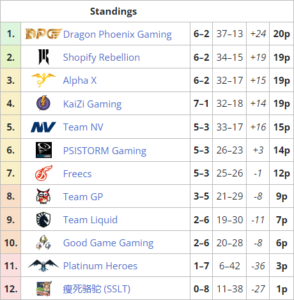
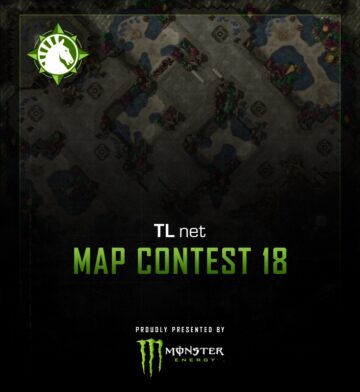
![[BSL17] ProLeague - RO16 Group Stage](https://platogaming.com/wp-content/uploads/2023/10/bsl17-proleague-ro16-group-stage.png)
